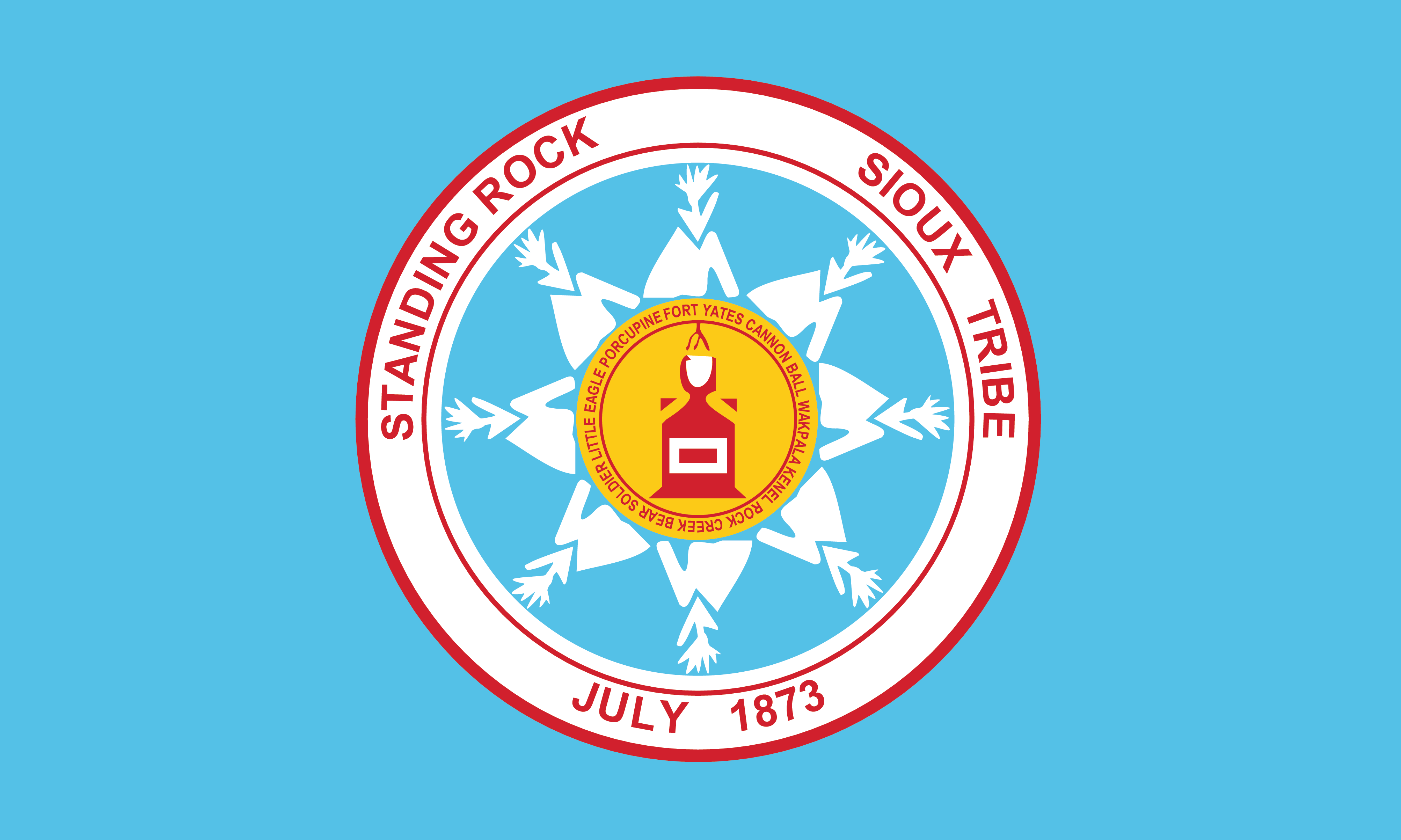
The flag of the Standing Rock Sioux Tribe.
CAIRNS ETANHAN WOTANIN
By Center for American Indian Research and Native Studies
For The Lakota Country Times
lakotacountrytimes.com This week we continue our examination of the nine flags of nations with reservation lands in South Dakota. Last week we evaluated the Cheyenne River Sioux Tribe flag and awarded its design 2 out of 5 stars. That put it at the bottom of our scoreboard so far, with the flags of the Rosebud Sioux (3 stars), Yankton Sioux (3.5 stars) and Oglala Sioux (4.5 stars) tribes above it. Let’s see if the Standing Rock Sioux Tribe flag can do better! Remember, flag designs can earn up to one star for each of the five principles of good flag design identified by Ted Kaye in his pamphlet, Good Flag, Bad Flag: How to Design a Great Flag. They are 1) keep it simple, 2) make it meaningful, 3) use 2-3 colors, 4) avoid numbers and letters, and 5) be distinctive. So with that in mind, let’s take a look at the Standing Rock Sioux Tribe flag. The background is medium blue. In a yellow disk at its center is a red and white pedestal supporting the stone form that gives Standing Rock its name. A thin red circular line encircles the pedestal and rock. Between this stripe and the edge of the yellow disk are the names of Standing Rock Reservation’s eight districts. Around the yellow disk are eight stylized white tipis. Encircling the tipis are four bands: a narrow band of white, then a thin red line, a wide white band and finally another red band. Within the wider white band and dividing it into thirds are the words “Standing Rock,” “Sioux Tribe” and “July 1873.” This date is probably in reference to when the Standing Rock Agency, known then as Grand River Agency, was moved to its present location. Now that we’ve taken a good look at the flag, let’s see how it rates according to the five principles of good flag design. At first glance, it looks simple enough; just a seal on a solid blue field, right? However, seals usually are a mixed bag from a design standpoint. Official seals like this, with all their carefully thought-out detail, are awfully complex. Therefore no star is gained for simplicity of design. On the other hand, it’s quite clear that there’s a lot of meaning jammed into that circle, from Standing Rock’s namesake to its eight districts. The flag certainly deserves a full star for the second principle—“make it meaningful”—plus a second star for its use of just a handful of basic colors. And, like most of the flags we’ve looked at in this series, it uses words and dates to supplement the existing symbolism. So it can’t gain another star for avoiding letters or numbers. That just leaves the flag’s distinctiveness to evaluate. Now this is certainly an “eye of the beholder” issue, but with so many flags that take an official seal and place it on a solid background, one can argue that the Standing Rock Sioux Tribe’s flag does not distinguish itself from the rest of the field. However, since the stylized Standing Rock in the center helps the seal stand out, in the end the flag earns half a star for distinctiveness. Therefore, the Standing Rock Sioux Tribe flag gets a 2.5 star rating. This keeps it out of the bottom of the standings (sorry Cheyenne River!), but the Oglala Sioux Tribe’s flag still holds on to its lead. Next week, we’ll see if the Sisseton Wahpeton Oyate’s flag can knock it off the top spot! (The Center for American Indian Research and Native Studies (CAIRNS), based in Martin, South Dakota, is an Indian-controlled nonprofit research and education center that is committed to advancing knowledge and understanding of American Indian communities and issues important to them by developing quality educational resources and innovative projects that acknowledge and incorporate tribal perspectives, and by serving as a meeting ground for peoples and ideas that support those perspectives.) Find the award-winning Lakota Country Times on the Internet, Facebook and Twitter and download the new Lakota Country Times app today.
Join the Conversation
Related Stories
CAIRNS
Column: Examining the flag from the Oglala Sioux Tribe (10/5) CAIRNS Column: Examining the flag of the Rosebud Sioux Tribe (09/19)
CAIRNS Column: Examining the flag of the Yankton Sioux Tribe (09/09)
